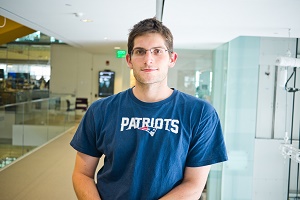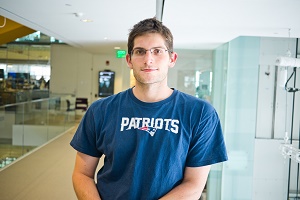Intelligent Automation: Will it Take Our jobs or Make Them Better? (Part 2 of 2)
Blog: Appian Insight

(This is the final installment of a two-part conversation with MIT Media Lab Researcher Morgan Frank (@mrfrank5790) on the challenge of embracing automation without leaving people behind. Read part 1 here.)
It’s tempting to talk about automation in the context of chasing efficiency. But the rise of automation is also a trend that’s disrupting workers and smaller communities more than ever before. Which means the most successful companies will get the most out of automation by making it easier for humans to collaborate with machines and other workers as well.
In the last episode, Frank highlighted some of the key findings of his groundbreaking research on the impact of automation (“Small Cities Face Greater Impact From Automation”). He talked about the urgency of focusing on making our workers more resilient to disruptive trends. He also dished on the importance of re-skilling at-risk workers, the never-ending volatility of tasks, and skills and how it tends to bubble up as disruption of employment and wages in the labor markets of smaller cities.
Appian: Can you give us some real-life examples of that kind of disruption?
Frank: There’s an economist at Boston University, named James Bessen, who made an important observation about bank tellers, and automated telling machines (ATMs). You might expect that with the ubiquity of ATMs, national employment for bank tellers would go down as ATM usage rises. But the opposite is true. Bessen showed that overall employment for bank tellers increased proportional to the increased use of ATMs.
That surprised many people. But there are two reasons why this happened. First, the efficiency of ATMs made it cheaper for Banks to open branches. Fewer tellers were employed per branch. But there was an overall increase in nationwide employment. The other factor to consider is that the tasks traditionally associated with bank tellers fundamentally changed. It used to be that they did mostly clerical, routine, work. Count money. Give you change back. But ATM’s freed them up to act more like customer service representatives and salespeople for bank products.
Time to Rethink How Work Gets Done
Appian: So, tellers transitioned from clerical work, to doing higher-level work that adds more value.
Frank: Yes. And that kind of work requires more social skills. This is the kind of occupational redefinition that I mentioned earlier. And we’re trying to understand this and model it even better.
Appian: So, it sounds like the impact of automation is less about job displacement than about the challenge of rethinking how work gets done.
Frank: Exactly.
“In addition to job creation from new technology, there is also a lot of redefinition going on. And that’s the bulk of the impact of automation (on the workforce).”
Appian: That said, what can a traditional company do in terms of preparing its workforce for intelligent automation? What can long-standing companies do to prepare for the smart technology of the future?
Frank: The thing is to understand who in your labor force is going to be in competition with these emerging technologies. Let’s say you operate several factories. And a new robotic arm will allow you to reduce jobs related to a specific assembly line task. The question is, what will you do with the workers that you will no longer need?
Appian: The traditional approach would be to lay them off.
Frank: Yes. Or you can retrain them to work at one of your other locations to perform tasks that you still need human labor to perform. But this requires a deep understanding of your workers’ skills—what’s going to be replaced by technology? What skills will still be in demand? And how will you match the skills of your workers with expected demand?
Appian: So, what’s the secret to doing that? What’s the best approach?
Frank: Right now, there’s no road map. This is something that the research community is trying to identify. Based on aggregated trends, I can make some general recommendations. For example, if you can teach your workers to work with computers, and perform cognitive and social tasks, then they are more likely to be augmented by technologies that we now see in the pipeline. Over longer time frames, social skills are a special topic that the research community is interested in. It seems like social skills really don’t have any competition in technology.
“It’s harder for technology to replace human interaction in many important ways. For example, I don’t think customer service will go total automation anytime soon.”
And also, the way deals are struck seems to rely more on networking and social capital. And this isn’t something that’s going to be automated away.
Appian: What were some of the surprising things you learned from your research on automation and its impact on cities?
Frank: The cities that are surprisingly resilient to the rise of automation are small cities that house universities or a critical mass of government offices.
Appian: Any specific cities come to mind?
Frank: Yes, Burlington, Vermont and Boulder, Colorado. These are relatively small major cities. But they are outliers on many important economic indicators—like GDP per capita, and health and well-being. Universities are driving local economies that can support demand for high skill workers—workers who can use cutting-edge technology rather than compete with it. In Boulder, we’re seeing a “Latte” town that’s growing into a larger city.
I say that because we’re seeing an increased presence of the tech industry in Colorado. Google is opening a big office there. Facebook and Twitter also have a presence there now. And I think this will change things for Boulder.
The Best Technology Works like Magic
Appian: From an emerging tech standpoint, we’re still in the early stages of digital transformation.
But what are your expectations in terms of what the relationship between people and technology will look like in the future?
Frank:
“I think it’s going to become increasingly hard to recognize that you’re working with technology. At the Media Lab, for example, we think that working with really good technology is like working with magic. That’s the type of interface we want. You’ve really nailed it when you can do that.”
Appian: Modern smartphones are kind of magical like that.
Frank: Yes. You can pull this little cube out of your pocket, and out of thin air, you find virtually any information you want, you can just pull it out of thin air. And there’s something sort of magical about that.
AI Goes Beyond Information Retrieval
Appian: What are your expectations for artificial intelligence (AI)?
Frank: So, I think we’re going to see more and more AI and algorithms that are doing more than just information retrieval. They will become a bigger presence in our daily lives. And you might not notice it so much, because of the gradual change. In the Media Lab, psychologists are working with children to study how they interact with things like Amazon Echo and other digital assistants. We’re looking at what these interactions do to their social skills and their expectations for interacting with other “dumber” technologies.
Appian: And what are you learning from these observations?
Frank: So, what we’re seeing is that children are willing to interact with digital assistants. But they’re a little confused about whether the technology is a person.
“As adults, we’re going to see more instances where data about us is being used without us knowing it, to drive conveniences that we expect. Amazon Echo is a good example of that. It can play the radio shows that you like. It can tell you about the traffic or the weather. And it can do these things automatically.”
Regulators, Behind the Digital Curve
Appian: What do you make of critics who fear AI and worry about the misuse of it?
Frank: There will be a down side. I can’t provide you with the science on it. But I do believe fake news will get worse. And as a society, we need to solve this problem. Usually, scientists develop new technology and leave it to the regulators to regulate how it’s used. And that’s healthy and good. But I don’t think that regulators are keeping up with emerging technologies. And they need to pick up the slack.
Appian: Looking at 2018 and beyond, give me your top three expectations in terms of the digital trends that are on your radar.
Frank: I think that occupational polarization is going to increase in the next few years. Part of this will be due to the distinction between competing technology and augmenting technology. Also, I think many economists will agree that the impact of technology is increasing at an increasing rate. So, from an educational policy perspective, this is a hard problem because public policy is even more sluggish than science.
So, I think improving educational policy in the face of fast changing technology is going to be huge.
Leave a Comment
You must be logged in to post a comment.








